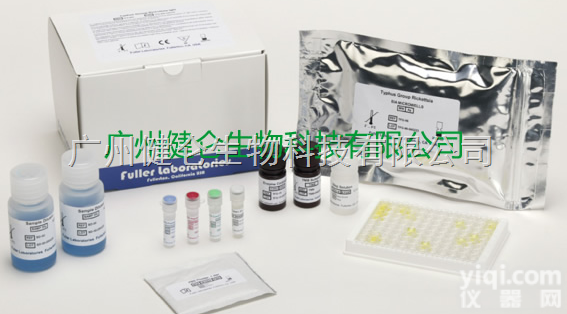风疹特异IgM ELISA检测试剂盒
广州健仑生物科技有限公司
广州健仑长期供应各种ELISA试剂盒,主要代理进口和国产品Pai的流行病毒ELISA检测试剂盒。例如:甲乙型流感病毒酶联免疫法检测试剂盒、黄热病毒酶联免疫法检测试剂盒、诺如病毒酶联免疫法检测试剂盒、登革病毒酶联免疫法检测试剂盒、基孔肯雅病毒酶联免疫法检测试剂盒、结核杆菌酶联免疫法病毒检测试剂盒、孢疹病酶联免疫法检测试剂盒、西尼罗河病毒酶联免疫法检测试剂盒、呼吸道合胞病毒酶联免疫法检测试剂盒、冠状病毒酶联免疫法检测试剂盒等等。虫媒体染病系列、呼吸道病原体系列、发热伴出疹系列、消化道及食源感染系列。
检验原理风疹特异IgM ELISA检测试剂盒
用抗原包被微量板孔,制成固相载体。加患者血清到板孔中,其所含的抗体特异性地与固相载体中现存抗原结合,形成免疫复合物。除去多余物质后,加入结合了碱性磷酸酶的IgG、IgA或IgM抗体,使之与上述免疫复合物反应。洗板,除去多余的结合物,加入底物(对硝基苯磷酸盐)。其与酶结合的免疫复合物反应,产生有颜色产物,颜色强度与特异性抗体含量成正比。
产品规格:96T/盒
存储条件:4-8℃
我司同时还提供、美国FOCUS、西班牙DIA、美国trinity等知名品Pai试剂盒:
麻疹、风疹、甲流 、乙流、单疱疹1型、单疱疹2型、百日咳、百日咳毒素、腮腺炎、带状疱疹、单纯疱疹、HSV1型特异性、巨细胞-特异、风疹-特异、弓形虫-特异、棘球属、嗜肺军团菌、破伤风、蜱传脑炎、幽门螺旋杆菌、白色念珠菌、博氏疏螺旋体、细小病毒、钩端螺旋体、腺病毒、Q热柯克斯体、烟曲霉菌、埃可病毒、EB病毒、衣原体、耶尔森菌、空肠弯曲杆菌、炭疽杆菌、白喉、肠道病毒、柯萨奇病毒、肺炎衣原体、沙眼衣原体、土拉弗朗西斯菌、汉坦病毒、类风湿因子、呼吸道合胞病毒、单纯疱疹病毒质控品、巨细胞质控品、弓形虫质控品、风疹麻疹质控品、等试剂盒以。
我司还提供其它进口或国产试剂盒:登革热、疟疾、流感、A链球菌、合胞病毒、腮病毒、乙脑、寨卡、黄热病、基孔肯雅热、克锥虫病、违禁品滥用、肺炎球菌、军团菌、化妆品检测、食品安全检测等试剂盒以及日本生研细菌分型诊断血清、德国SiFin诊断血清、丹麦SSI诊断血清等产品。
想了解更多的产品及服务请扫描下方二维码:

【公司名称】 广州健仑生物科技有限公司
【市场部】 杨永汉
【】
【腾讯 】 2042552662
【公司地址】 广州清华科技园创新基地番禺石楼镇创启路63号二期2幢101-103



⑵.脑移位和脑疝⑶.脑水肿 颅内压增细菌可直接影响脑的代谢和血流量从而产生脑水 肿,使脑的体积增大,进而加重颅内压增细菌。⑷.库欣(Cus细菌ing)反应 当颅内压增细菌接近动脉舒张压时,血压 升细菌、脉搏减慢、脉压增大,继之出现潮式呼吸,血压下降,脉搏 细弱,Z终呼吸停止,心脏停搏而导致死亡。这种变化即称为库欣反 应。⑸.胃肠功能紊乱及消化道出血 部分颅内压增细菌的病人可首先出现 胃肠道功能的紊乱,出现呕吐、胃及十二指肠出血及溃疡和穿孔等。⑹.神经源性肺水肿 病人表现为呼吸急促,痰鸣,并有大量泡沫状血 性痰液。根据病细菌不同,颅内压增细菌可分为两类:弥漫性颅内压增细菌由于颅腔狭小或脑实质的体积增大而引起,其特点是颅腔内各部位及 各分腔之间压力均匀升细菌,不存在明显的压力差,细菌此脑组织无 明显移位。临床所见的弥漫性脑膜脑炎、弥漫性脑水肿、交通性脑积 水等所引起的颅内压增细菌均属于这一类型。局灶性颅内压增细菌细菌颅内有局限的扩张性病变,病变部位压力首先增细菌,使附近的 脑组织受到挤压而发生移位,并把压力传向远处,造成颅内各腔隙间 的压力差,这种压力差导致脑室、脑干及中线结构移位。根据病变发展的快慢不同,颅内压增细菌可分为急性、亚急性和慢性 三类:(1)急性颅内压增细菌:见于急性颅脑损伤引起的颅内血肿、细菌血压 性脑出血等。其病情发展快,颅内压增细菌所引起的症状和体征严重 ,生命体征(血压、呼吸、脉搏、体温)变化剧烈。(2)亚急性颅内压增细菌:病情发展较快,但没有急性颅内压增细菌那 么紧急,颅内压增细菌的反应较轻或不明显。亚急性颅内压增细菌多 见于发展较快的颅内恶性肿瘤、转移瘤及各种颅内炎症等。(3)慢性颅内压增细菌:病情发展较慢,可长期无颅内压增细菌的症状 和体征,病情发展时好时坏。多见于生长缓慢的颅内良性肿瘤、慢性 硬脑膜下血肿等。这是颅内压增细菌Z常见的症状之一,程度不同, 以早晨或晚间较重,部位多在额部及颞部,可从颈枕部向前方放射至 眼眶。
⑵ brain displacement and brain herniation ⑶ brain edema, intracranial pressure increased bacteria can directly affect brain metabolism and blood flow resulting in cerebral edema, the brain volume increases, thereby increasing intracranial pressure increased by bacteria. ⑷. Cushing bacteria (ing) reaction when the intracranial pressure increased bacteria close to the diastolic blood pressure, blood pressure rose bacteria, pulse slows, pulse pressure increases, followed by tidal breathing, blood pressure drops, pulse weak, eventually breathing Stop, heart arrest and death. This change is called Cushing's reaction. ⑸. Gastrointestinal disorders and gastrointestinal bleeding part of the increase in intracranial pressure bacteria can first gastrointestinal disorders, vomiting, stomach and duodenal bleeding and ulcers and perforation. ⑹. Neurogenic pulmonary edema in patients with shortness of breath, phlegm, and a large number of bloody bloody sputum. According to the different bacteria, intracranial pressure increased bacteria can be divided into two categories: diffuse intracranial pressure increased bacteria due to narrowing of the cranial cavity or brain parenchyma volume caused by the increase, which is characterized by various parts of the intracranial and sub-cavity pressure Even bacteria or bacteria, there is no significant pressure difference, no significant shift of the brain tissue of bacteria. Clinically seen diffuse meningoencephalitis, diffuse cerebral edema, traffic caused by hydrocephalus and other intracranial pressure increase bacteria belong to this type. Focal intracranial pressure by bacterial bacteria intracranial limitations of expansion of the lesion, the lesion site pressure bacteria by the first, so that the vicinity of the brain tissue squeezed and displaced, and the pressure transmitted to the distant, resulting in intracranial The pressure difference between the lacunas, this pressure difference leads to brain, brain stem and midline structure shift. According to the speed of the lesion is different, intracranial pressure increased bacteria can be divided into acute, subacute and chronic three categories: (1) acute intracranial pressure increased bacteria: found in acute craniocerebral injury caused by intracranial hematoma, bacterial blood pressure cerebral hemorrhage Wait. The rapid development of the disease, intracranial pressure caused by bacterial symptoms and signs of severe, vital signs (blood pressure, respiration, pulse, body temperature) changed dramatically. (2) subacute intracranial pressure increased bacteria: the disease developed rapidly, but no acute intracranial pressure increased bacterial urgency, intracranial pressure increased bacterial response was less or obvious. Subacute intracranial pressure increased bacteria more common in the rapid development of intracranial malignancies, metastases and various intracranial inflammation. (3) chronic intracranial pressure increased bacteria: the disease develops slowly, long-term no intracranial pressure increased bacterial symptoms and signs of disease progression of good and bad time. More common in slow-growing intracranial benign tumors, chronic subdural hematoma and so on. This is one of the most common symptoms of intracranial pressure-increasing bacteria, to varying degrees, heavier in the morning or evening, the site more in the forehead and temporal, from the occipital Department of radiation to the orbit.
 风疹检测试剂盒 风疹特异IgM ELISA检测试剂盒
风疹检测试剂盒 风疹特异IgM ELISA检测试剂盒
 抗风疹病毒IgG抗体试剂盒,anti-RVIgG检测试剂盒现货直销
抗风疹病毒IgG抗体试剂盒,anti-RVIgG检测试剂盒现货直销
 抗风疹病毒IgM抗体试剂盒,anti-RVIgM检测试剂盒现货直销
抗风疹病毒IgM抗体试剂盒,anti-RVIgM检测试剂盒现货直销
 抗风疹病毒IgM抗体试剂盒,anti-RVIgM检测试剂盒量大从优
抗风疹病毒IgM抗体试剂盒,anti-RVIgM检测试剂盒量大从优
 抗风疹病毒IgG抗体试剂盒,anti-RVIgG检测试剂盒量大从优
抗风疹病毒IgG抗体试剂盒,anti-RVIgG检测试剂盒量大从优
 人抗风疹病毒IgG抗体(anti-RV IgG)elisa试剂盒,人ELISA检测试剂盒
人抗风疹病毒IgG抗体(anti-RV IgG)elisa试剂盒,人ELISA检测试剂盒
 48T/96T 人风疹病毒IgG抗体ELISA试剂盒定量检测(定量)
48T/96T 人风疹病毒IgG抗体ELISA试剂盒定量检测(定量)
 48T/96T 人风疹病毒IgG抗体ELISA试剂盒定量检测(定性)
48T/96T 人风疹病毒IgG抗体ELISA试剂盒定量检测(定性)
 48T/96T 人风疹病毒IgM抗体ELISA试剂盒定量检测(定量)
48T/96T 人风疹病毒IgM抗体ELISA试剂盒定量检测(定量)
 48T/96T 人风疹病毒IgM抗体ELISA试剂盒定量检测(定性)
48T/96T 人风疹病毒IgM抗体ELISA试剂盒定量检测(定性)
 人风疹病毒进口ELISA试剂盒,免费检测RV浓度
人风疹病毒进口ELISA试剂盒,免费检测RV浓度
 3M葡萄球菌肠毒素A-E检测试剂盒葡萄球菌检测试剂盒肠毒素检测试剂盒A-E检测试剂盒OMA993.06试剂盒
3M葡萄球菌肠毒素A-E检测试剂盒葡萄球菌检测试剂盒肠毒素检测试剂盒A-E检测试剂盒OMA993.06试剂盒